Chilingarian G.V. et al. Surface Operations in Petroleum Production, II
Подождите немного. Документ загружается.


325
TABLE
9-111
Cumulative volume of suspended solids
a
Suspended solids
concentration in 15.5-lb/ft liner
injection water
(PP@
Height
of
fill in ft after one year in 5
1/2
in.
500
bbl/day 1000 bbl/day 2500 bbl/day
1
5
10
5.3
26.2
52.5
10.5
52.3
105
26.3
131
263
a Assumptions:
(1)
None of the solids enter the formation. (2) Solids have a specific gravity
of
2.5
g/ml.
(3) Solids settle to a porosity
of
40%.
An appreciation for the cumulative volume
of
suspended solids in a liner if none
of the solids enter the formation may be gained by looking at Table 9-111. This is the
extreme case, however. Injectivity falloff occurs long before fill heights occur, as
noted for
2500
bbl/day injection rate in Table 9-111. The factors which determine
the ability of the suspended solids to enter the formation include:
(1)
the size
of
the
pores and pore channels in the formation,
(2)
the size distribution of the suspended
solids,
(3)
the tendency of the suspended solids to agglomerate, and
(4)
the presence
of oil, grease,
or
film-forming chemicals, whch bind or glue the suspended solids
together.
If suspended solids consisting solely of sand are strained out on the formation
face, they cause no loss of injectivity until the formation face is appreciably covered
by fill. On the other hand, if suspended solids consisting
of
clay and silt are strained
out on the formation face, they form a filter cake, causing very serious loss of
injectivity. Suspended solids consisting of fine silt and heavy oil have the same
effect as clay and silt.
The best generalization that can be made about suspended solids is that the fewer
solids there are in the water, the better the water. If at all possible, the water should
be kept completely free
of
particular matter, unless it is known that the solids can
enter the formation and no adherent solids are present. In the absence of informa-
tion to the contrary, it should always be assumed that suspended solids will be
screened out on the rock face and, thus, cause an increase in injection pressures
(Baker, 1958; Spencer and Harding, 1959).
SCALE
The term scale refers to an adherent solid deposited on a surface. The following
forms of scale are possible in water injection systems, depending upon cir-
cumstances
:

3
26
Cause
of
scale formation Chemical name Mineral name
(1)
Loss
of
dissolved gases
Calcium carbonate
(2)
Solution
of
gases Ferric hydroxide
Ferrous sulfide
(3)
Commingling of waters Barium sulfate
Strontium sulfate
Calcium sulfate
Calcium carbonate
(4)
Heating without Calcium carbonate
evaporation
Calcium sulfate
Mixed iron oxide
Ferrous ferricyanide
(5)
Incompatible chemicals Calcium phosphate
Calcite,
aragonite
Goethite
Amorphous iron
sulfide
Barite
Celestite
Gypsum
Calcite,
aragonite
Calcite,
aragonite
Gypsum, anhydrite
Magnetite
Hydroxyapatite
Scales may be found at any point in a water injection system. It is a good
generalization that prevention of scale formation is the wisest procedure. Carbonate,
hydroxide, oxide, and sulfide scales may be removed by acidizing, whereas sulfate,
phosphate, and ferricyanide scales are not soluble in acid. They are very difficult, if
not impossible, to remove by means other than mechanical.
Calcium carbonate scale
Calcium carbonate scaling is a function of pH, temperature, ionic strength of the
solution, the calcium ion concentration, and the bicarbonate ion concentration. The
chemistry of calcium carbonate deposition can be shown by the following formulas:
HZCO,
=
CO,
Carbonic acid Carbon dioxide
H+
+
HCO;
Hydrogen ion Bicarbonate ion
Hydrogen ion Carbonate ion
Ca(HC0,
12
=
CaCO,
Calcium bicarbonate Calcium carbonate
Calcium ion Carbonate ion
H+
+
c0;-
Ca2+
+
c0:-
+
H,O
(9-1)
=
H,CO,
(9-2)
=
HCO,
(9-3)
+
H,CO,
(9-4)
=
CaCO, (9-5)
Water
Carbonic acid
Bicarbonate ion
Carbonic acid
Calcium carbonate
Any action wluch causes eqs. 9-1, 9-2, 9-4, and 9-5 to shift to the right may cause
the deposition of calcium carbonate. The following may cause one or more
of
the
equilibria to shift to the right: (1) an increase in temperature, (2) a loss of dissolved
carbon dioxide, and
(3)
an increase in pH.

321
Stiff and Davis (1952) have greatly extended the excellent early work of Langelier
(1946) on the stability index of waters with regard to their tendency to deposit
calcium carbonate scale. The stability index
(SI)
is defined as follows:
SI
=
pH
-
pCa
-
pAlk
-
K
where pCa
=
-
log(Ca2+), pAlk
=
-
log(Alkalinity), and
K
is the ionic activity at a
particular temperature. A positive stability index denotes a corrosive tendency. The
stability index predicts the future behavior
of
the water.
No
estimate, however, can
be made of past scaling.
Calcium carbonate scale formation may be prevented by any one of the following
actions:
(1)
Lowering of the pH until the stability index becomes zero or slightly negative.
(2) Adding an effective scale inhibitor.
(3)
Removing the calcium ion by any one of the following means: (a) ion
exchange, if fresh water, (b) precipitation, (c) chelation, and (d) dilution to below
the solubility limit.
Sulfate scales
The sulfate scales wluch occur in waterflood operations are as follows:
(1)
barium
sulfate,
(2)
calcium sulfate (anhydrite or gypsum), and
(3)
strontium sulfate.
These three types of scales are normally caused by commingling of two waters:
one containing sulfate ion and the other containing barium, strontium, or calcium
ion. Calcium sulfate scale also may occur when temperatures are raised sufficiently
to decrease the solubility
of
calcium sulfate to the point where precipitation occurs.
Prevention of sulfate scales in the first case normally is done by not mixing
incompatible waters. When this cannot be avoided, one may follow one
of
the
following procedures: (1) allowing precipitation, and then filtering off precipitate,
(2) adding a scale inhibitor,
(3)
removing the barium, strontium,
or
calcium ion by
ion exchange, if a fresh water,
(4)
chelating the barium, strontium, or calcium ion,
and
(5)
diluting the offending ion to below solubility limit.
CORROSION
Corrosion is a costly item in waterflooding and must be dealt with immediately
when detected. The onset of corrosion is usually insidious and the operator is lulled
into a false sense of security.
One must understand the causes of corrosion in order to prevent it or stop it after
it has started. It is relatively easy to protect a new, clean system, whereas it may be
very difficult,
if
not impossible,
to protect a corroded, dirty system, because
protective chemicals seldom can penetrate deposits or enter deep pits filled with
corrosion products. Corrosion in waterflooding operations is caused by: (1) galvanic
action, (2) stray currents,
(3)
dissolved gases, and (4) bacterial action. Any mecha-
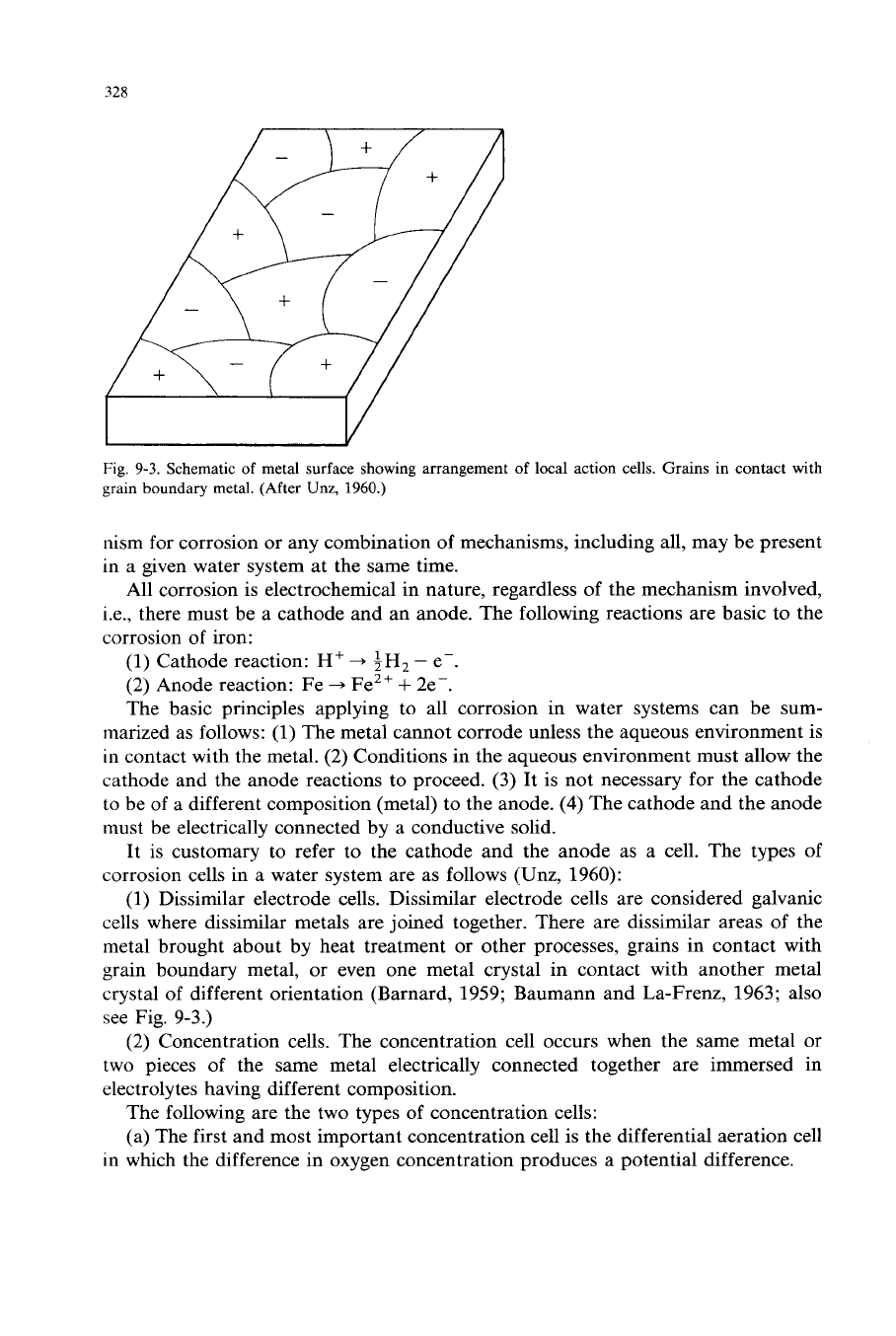
328
Fig.
9-3.
Schematic
of
metal surface showing arrangement
of
local action cells. Grains in contact with
grain
boundary metal. (After
Unz,
1960.)
nism for corrosion or any combination of mechanisms, including all, may be present
in a given water system at the same time.
All corrosion is electrochemical in nature, regardless of the mechanism involved,
i.e., there must be a cathode and an anode. The following reactions are basic to the
corrosion
of
iron:
(1) Cathode reaction:
H+
+
&HI
-
e-.
(2) Anode reaction: Fe
+
Fe2+
+
2e-.
The basic principles applying to all corrosion in water systems can be sum-
marized as follows: (1) The metal cannot corrode unless the aqueous environment is
in contact with the metal. (2) Conditions in the aqueous environment must allow the
cathode and the anode reactions to proceed.
(3)
It is not necessary for the cathode
to
be of a different composition (metal) to the anode.
(4)
The cathode and the anode
must be electrically connected by a conductive solid.
It
is
customary to refer to the cathode and the anode as a cell. The types of
corrosion cells in a water system are as follows (Unz, 1960):
(1) Dissimilar electrode cells. Dissimilar electrode cells are considered galvanic
cells where dissimilar metals are joined together. There are dissimilar areas of the
metal brought about by heat treatment or other processes, grains in contact with
grain boundary metal, or even one metal crystal in contact with another metal
crystal of different orientation (Barnard, 1959; Baumann and La-Frenz, 1963; also
see Fig. 9-3.)
(2) Concentration cells. The concentration cell occurs when the same metal or
two pieces of the same metal electrically connected together are immersed in
electrolytes having different composition.
The following are the two types of concentration cells:
(a) The first and most important concentration cell is the differential aeration cell
in which the difference in oxygen concentration produces a potential difference.
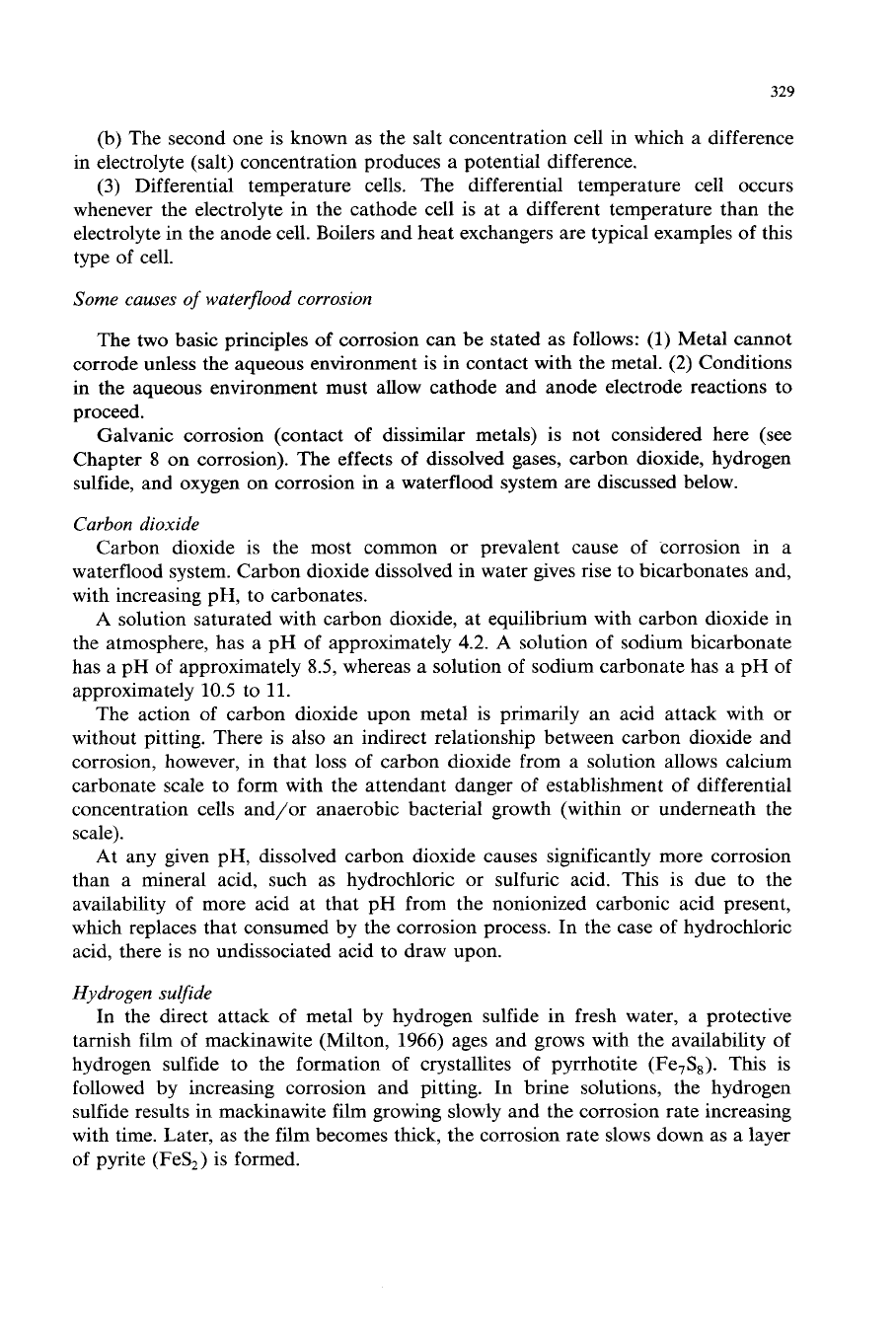
329
(b) The second one is known as the salt concentration cell in which a difference
in electrolyte (salt) concentration produces a potential difference.
(3)
Differential temperature cells. The differential temperature cell occurs
whenever the electrolyte in the cathode cell is at a different temperature than the
electrolyte in the anode cell. Boilers and heat exchangers are typical examples of this
type of cell.
Some causes
of
waterflood corrosion
The two basic principles of corrosion can be stated as follows:
(1)
Metal cannot
corrode unless the aqueous environment is in contact with the metal.
(2)
Conditions
in the aqueous environment must allow cathode and anode electrode reactions to
proceed.
Galvanic corrosion (contact of dissimilar metals) is not considered here (see
Chapter
8
on corrosion). The effects of dissolved gases, carbon dioxide, hydrogen
sulfide, and oxygen on corrosion
in
a waterflood system are discussed below.
Carbon dioxide
Carbon dioxide is the most common or prevalent cause of corrosion in a
waterflood system. Carbon dioxide dissolved in water gives rise to bicarbonates and,
with increasing pH, to carbonates.
A solution saturated with carbon dioxide, at equilibrium with carbon dioxide in
the atmosphere, has a pH of approximately
4.2.
A solution of sodium bicarbonate
has a pH of approximately 8.5, whereas a solution of sodium carbonate has a pH of
approximately 10.5 to 11.
The action of carbon dioxide upon metal is primarily an acid attack with or
without pitting. There is also an indirect relationship between carbon dioxide and
corrosion, however, in that loss of carbon dioxide from a solution allows calcium
carbonate scale to form with the attendant danger of establishment of differential
concentration cells and/or anaerobic bacterial growth (within or underneath the
scale).
At any given pH, dissolved carbon dioxide causes significantly more corrosion
than a mineral acid, such as hydrochloric or sulfuric acid. This is due to the
availability of more acid at that pH from the nonionized carbonic acid present,
which replaces that consumed by the corrosion process. In the case of hydrochloric
acid, there is no undissociated acid to draw upon.
Hydrogen
sulfide
In the direct attack of metal by hydrogen sulfide in fresh water, a protective
tarnish film of mackinawite (Milton, 1966) ages and grows with the availability of
hydrogen sulfide to the formation of crystallites of pyrrhotite (Fe,S,).
This
is
followed by increasing corrosion and pitting. In brine solutions, the hydrogen
sulfide results in mackinawite film growing slowly and the corrosion rate increasing
with time. Later, as the film becomes thick, the corrosion rate slows down as a layer
of pyrite (FeS,) is formed.

330
An indirect danger is that hydrogen sulfide causes depolarization of the cathode,
owing to precipitation of ferrous sulfide.
Saturation with carbon dioxide, as well as with hydrogen sulfide, retards the
development of the mackinawite tarnish and scale, resulting in lower corrosion
rates. In contrast, as the mackinawite scale thickens in the absence of carbon
dioxide, even higher corrosion rates result. There is a considerable amount of
variation in corrosion rates with hydrogen sulfide depending upon the corrosion
product. The nature of the corrosion product is influenced by the electrolyte
composition.
Oxygen
Oxygen is a prevalent, most serious cause of waterflood corrosion. The corrosion
rate caused by oxygen increases with increasing salinity until a level of approxi-
mately
1%
NaCl is reached. Above this salt concentration, the corrosion rate falls
off directly as the solubility of oxygen decreases with increasing salt concentration.
Thus, the reduction in corrosion rate is caused by the reduction in the amount of
available oxygen, and not by passivation. Similar effects are noted with other types
of salt solutions.
The corrosion rate in the pH range of
4-10,
is governed by the diffusion of
oxygen to the surface of the metal through the oxide or hydroxide film. The barrier
to
diffusion is the ferrous hydroxide, which is continuously supplied by corrosion as
it
is taking place. Under this layer of ferrous hydroxide, the approximate pH is
9.5
(the pH of a saturated solution of ferrous hydroxide). The ferrous hydroxide is
dissolved below a pH of
4
and the metal surface is placed in direct contact with the
electrolyte. In these low pH ranges, there is rapid corrosion, because of hydrogen
evolution and oxygen depolarization. The corrosion rate drops sharply above a pH
of
10,
because
of
passivation in the presence of oxygen and alkali.
Interactions
of
the gases
According to Dalton’s law of partial pressures, the total pressure by a mixture of
gases is equal to the sum of the partial pressures of each of the constituent gases.
The partial pressure is defined as the pressure each gas would exert if it alone
occupied the volume of the mixture at the same temperature.
Henry’s law applies in conjunction with Dalton’s law. The mass
of
a gas
dissolved by a given volume of solvent at constant temperature is proportional to
the pressure of the gas with which it is in equilibrium.
Owing to its higher absorption coefficient, oxygen occurs in the dissolved gases in
water at a significantly higher ratio than in the air with which the water is in
equlibrium. Both carbon dioxide and hydrogen sulfide, however, are far more
soluble in water than oxygen.
Generally speaking, the gases are less soluble in aqueous solutions
of
electrolytes
than in distilled water. This is known as the salting out effect. The salting out effect
of
a given salt is almost independent of the nature of the gas. Generally, the salting
effect of an ion from a dissolved salt is larger, the greater the charge the ion carries
and the smaller the size of the ion.
In the preceding discussion on solubility of oxygen and gases in water, equi-
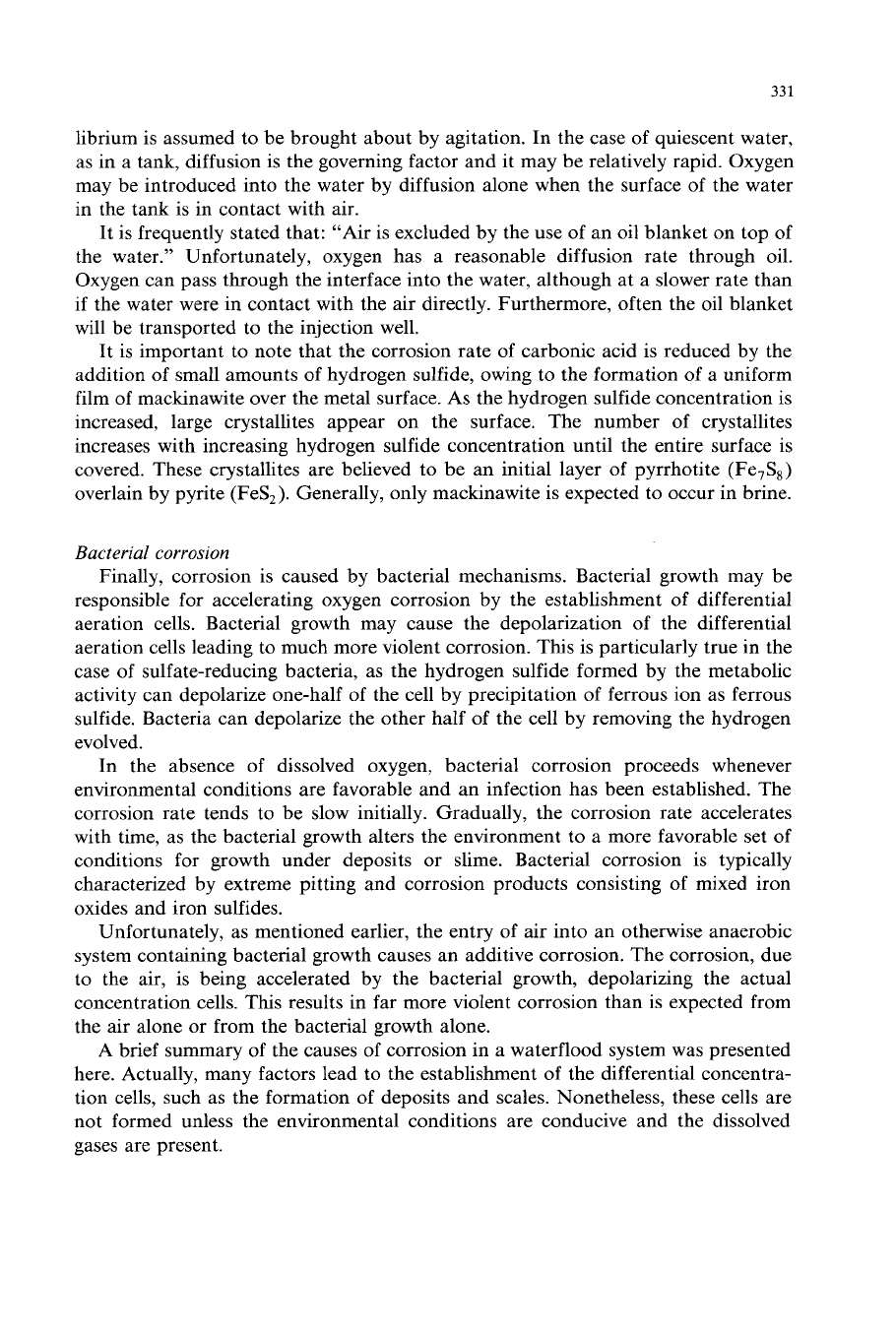
331
librium is assumed to be brought about by agitation. In the case of quiescent water,
as in a tank, diffusion is the governing factor and it may be relatively rapid. Oxygen
may be introduced into the water by diffusion alone when the surface of the water
in the tank is in contact with air.
It is frequently stated that: “Air is excluded by the use of an oil blanket on top of
the water.” Unfortunately, oxygen has a reasonable diffusion rate through oil.
Oxygen can pass through the interface into the water, although at a slower rate than
if the water were in contact with the air directly. Furthermore, often the oil blanket
will be transported to the injection well.
It is important to note that the corrosion rate of carbonic acid is reduced by the
addition of small amounts of hydrogen sulfide, owing to the formation of a uniform
film of mackinawite over the metal surface. As the hydrogen sulfide concentration is
increased, large crystallites appear on the surface.
The number of crystallites
increases with increasing hydrogen sulfide concentration until the entire surface is
covered. These crystallites are believed to be an initial layer of pyrrhotite (Fe,S,)
overlain by pyrite (FeS,). Generally, only mackinawite is expected to occur in brine.
Bacterial corrosion
Finally, corrosion is caused by bacterial mechanisms. Bacterial growth may be
responsible for accelerating oxygen corrosion by the establishment of differential
aeration cells. Bacterial growth may cause the depolarization of the differential
aeration cells leading to much more violent corrosion. This is particularly true in the
case of sulfate-reducing bacteria, as the hydrogen sulfide formed by the metabolic
activity can depolarize one-half of the cell by precipitation of ferrous ion as ferrous
sulfide. Bacteria can depolarize the other half of the cell by removing the hydrogen
evolved.
In the absence of dissolved oxygen, bacterial corrosion proceeds whenever
environmental conditions are favorable and an infection has been established. The
corrosion rate tends to be slow initially. Gradually, the corrosion rate accelerates
with time, as the bacterial growth alters the environment to a more favorable set
of
conditions for growth under deposits or slime. Bacterial corrosion is typically
characterized by extreme pitting and corrosion products consisting
of
mixed iron
oxides and iron sulfides.
Unfortunately, as mentioned earlier, the entry of air into an otherwise anaerobic
system containing bacterial growth causes an additive corrosion. The corrosion, due
to the air, is being accelerated by the bacterial growth, depolarizing the actual
concentration cells. This results in far more violent corrosion than is expected from
the air alone or from the bacterial growth alone.
A brief summary of the causes of corrosion in a waterflood system was presented
here. Actually, many factors lead to the establishment of the differential concentra-
tion cells, such as the formation of deposits and scales. Nonetheless, these cells are
not formed unless the environmental conditions are conducive and the dissolved
gases are present.
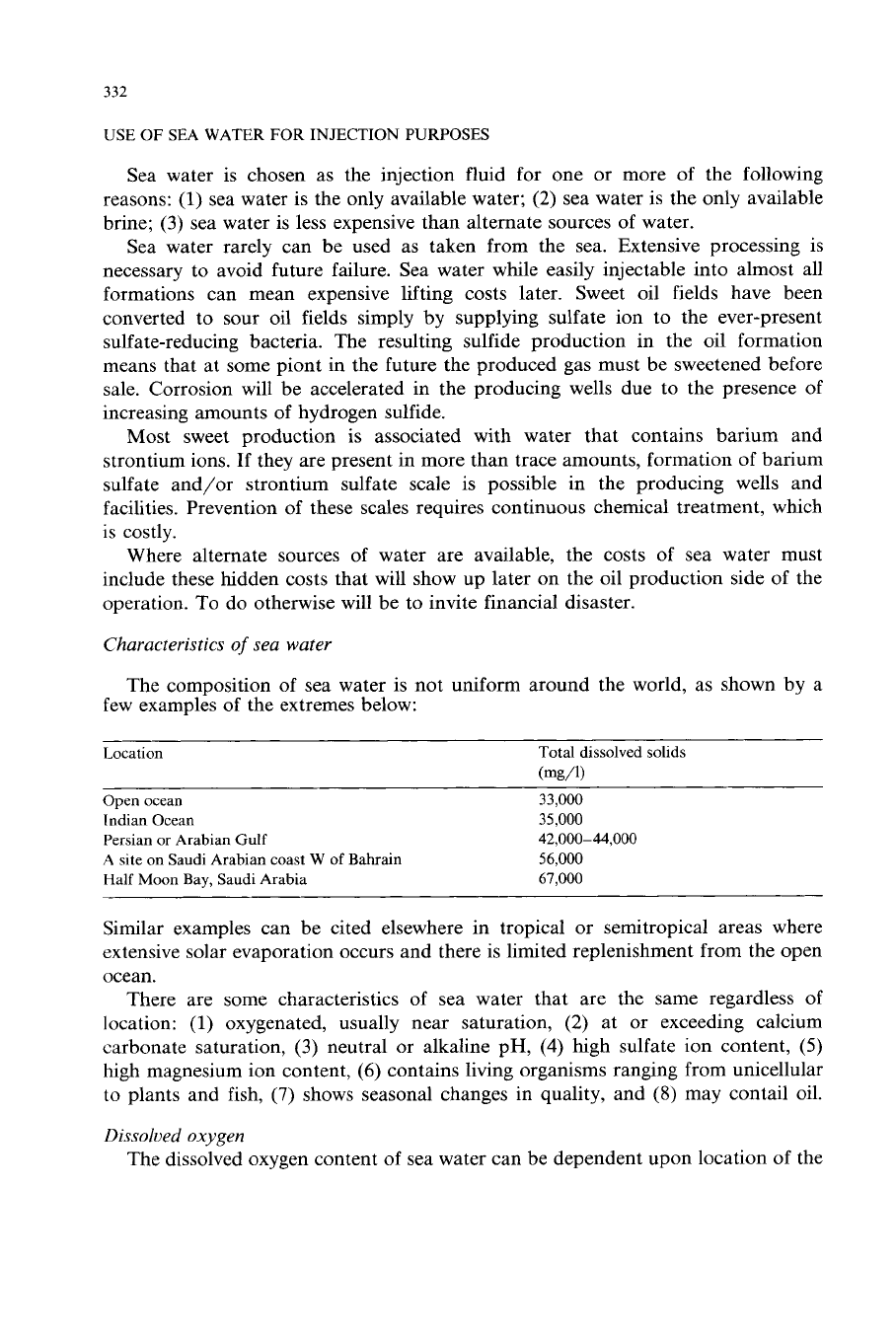
332
USE
OF
SEA WATER FOR INJECTION PURPOSES
Sea water is chosen as the injection fluid for one or more of the following
reasons:
(1)
sea water is the only available water;
(2)
sea water is the only available
brine;
(3)
sea water is less expensive than alternate sources of water.
Sea water rarely can be used as taken from the sea. Extensive processing is
necessary to avoid future failure. Sea water while easily injectable into almost all
formations can mean expensive lifting costs later. Sweet oil fields have been
converted to sour oil fields simply by supplying sulfate ion to the ever-present
sulfate-reducing bacteria. The resulting sulfide production in the
oil
formation
means that at some piont in the future the produced gas must be sweetened before
sale. Corrosion will be accelerated in the producing wells due to the presence of
increasing amounts
of
hydrogen sulfide.
Most sweet production is associated with water that contains barium and
strontium ions. If they are present in more than trace amounts, formation of barium
sulfate and/or strontium sulfate scale is possible in the producing wells and
facilities. Prevention of these scales requires continuous chemical treatment, which
is costly.
Where alternate sources
of
water are available, the costs of sea water must
include these hidden costs that will show up later on the oil production side of the
operation.
To
do otherwise will be to invite financial disaster.
Characteristics
of
sea water
The composition of sea water is not uniform around the world, as shown by a
few examples of the extremes below:
Location Total dissolved solids
(mg/l)
Open ocean 33,000
Indian Ocean 35,000
Persian or Arabian Gulf 42,000-44,000
A
site on Saudi Arabian coast W of Bahrain
56,000
Half Moon Bay, Saudi Arabia
67,000
Similar examples can be cited elsewhere in tropical or semitropical areas where
extensive solar evaporation occurs and there is limited replenishment from the open
ocean.
There are some characteristics of sea water that are the same regardless of
location:
(1)
oxygenated, usually near saturation,
(2)
at or exceeding calcium
carbonate saturation,
(3)
neutral or alkaline pH,
(4)
high sulfate ion content,
(5)
high magnesium ion content,
(6)
contains living organisms ranging from unicellular
to
plants and fish,
(7)
shows seasonal changes in quality, and
(8)
may contail oil.
Dissolved
oxygen
The dissolved oxygen content
of
sea water can be dependent upon location of the
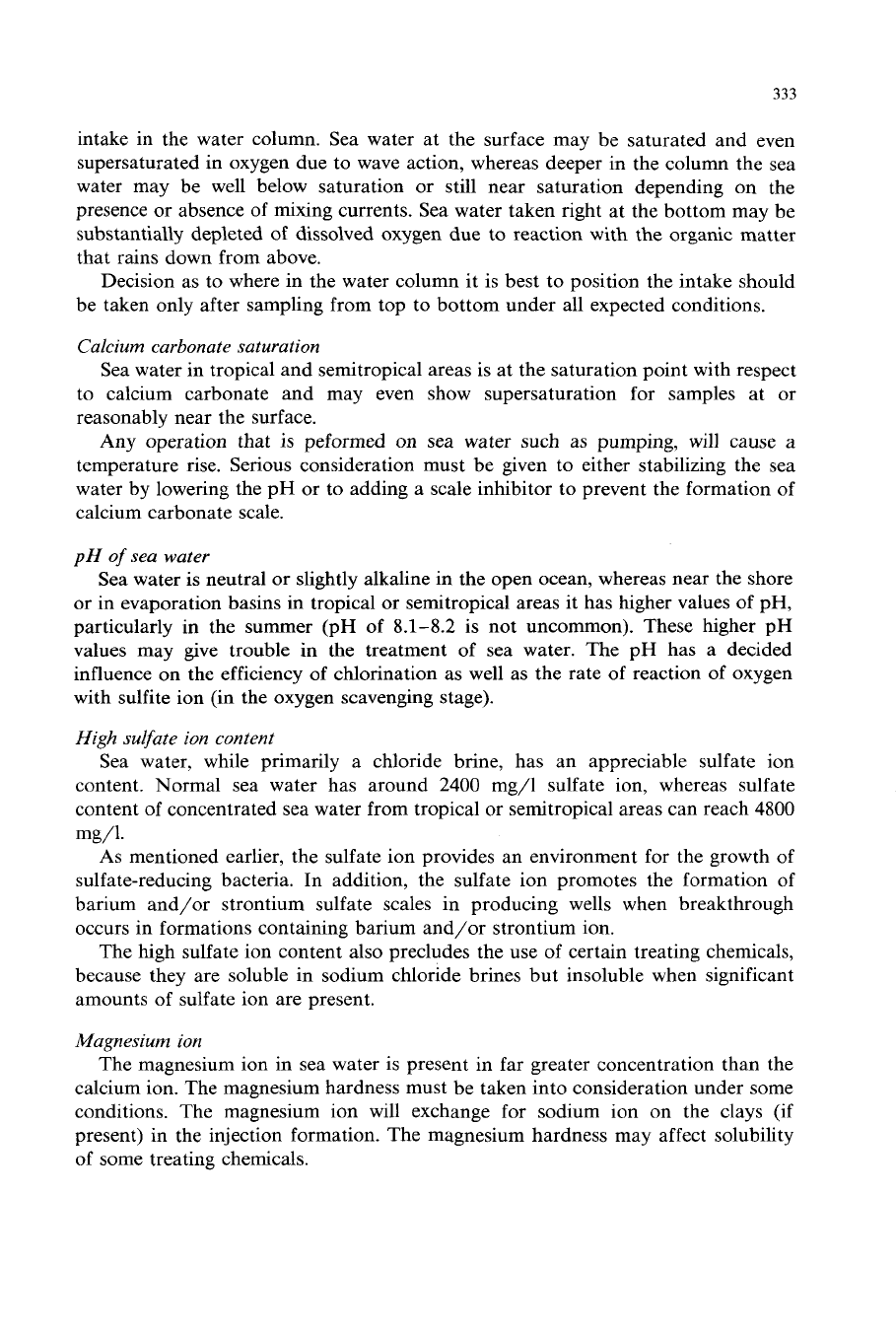
333
intake in the water column. Sea water at the surface may be saturated and even
supersaturated in oxygen due to wave action, whereas deeper in the column the sea
water may be well below saturation or still near saturation depending on the
presence or absence of mixing currents. Sea water taken right at the bottom may be
substantially depleted
of
dissolved oxygen due to reaction with the organic matter
that rains down from above.
Decision as to where in the water column it is best to position the intake should
be taken only after sampling from top to bottom under all expected conditions.
Calcium carbonate saturation
Sea water in tropical and semitropical areas is at the saturation point with respect
to calcium carbonate and may even show supersaturation for samples at or
reasonably near the surface.
Any operation that
is
peformed on sea water such as pumping, will cause a
temperature rise. Serious consideration must be given to either stabilizing the sea
water by lowering the pH or to adding a scale inhibitor to prevent the formation of
calcium carbonate scale.
pH
of
sea water
Sea water is neutral or slightly alkaline in the open ocean, whereas near the shore
or in evaporation basins in tropical
or
semitropical areas it has higher values
of
pH,
particularly in the summer (pH of 8.1-8.2 is not uncommon). These higher pH
values may give trouble in the treatment of sea water. The pH has a decided
influence
on
the efficiency of chlorination as well as the rate of reaction of oxygen
with sulfite ion (in the oxygen scavenging stage).
High sulfate ion content
Sea water, while primarily a chloride brine, has an appreciable sulfate ion
content. Normal sea water has around 2400 mg/l sulfate ion, whereas sulfate
content of concentrated sea water from tropical or semitropical areas can reach 4800
As
mentioned earlier, the sulfate ion provides an environment for the growth of
sulfate-reducing bacteria. In addition, the sulfate ion promotes the formation of
barium and/or strontium sulfate scales in producing wells when breakthrough
occurs in formations containing barium and/or strontium ion.
The high sulfate ion content also precludes the use of certain treating chemicals,
because they are soluble in sodium chloride brines but insoluble when significant
amounts of sulfate ion are present.
mg/l.
Magnesium
ion
The magnesium ion in sea water is present in far greater concentration than the
calcium ion. The magnesium hardness must be taken into consideration under some
conditions. The magnesium ion will exchange for sodium ion on the clays (if
present)
in
the injection formation. The magnesium hardness may affect solubility
of
some treating chemicals.
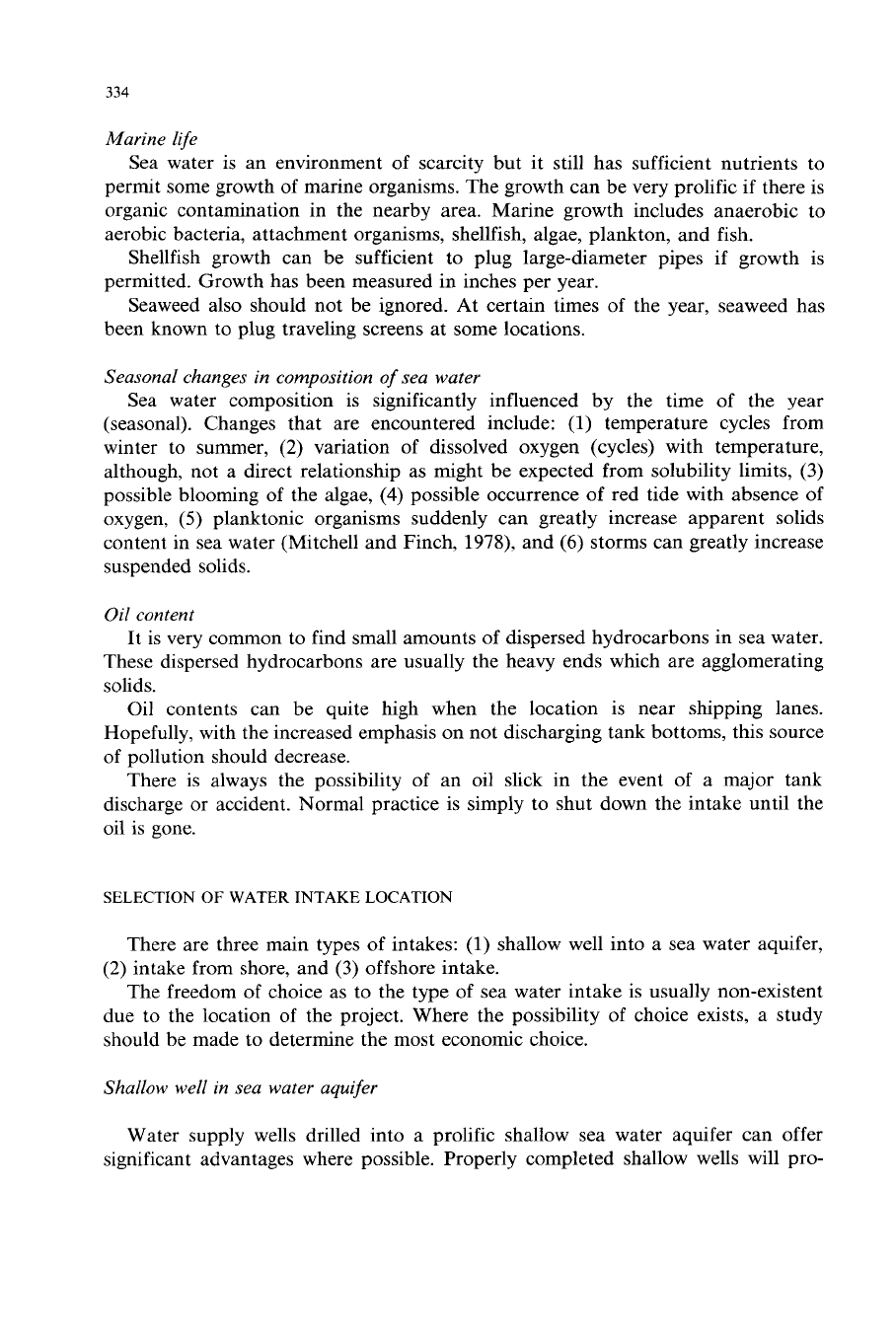
334
Marine life
Sea water is an environment of scarcity but it still has sufficient nutrients to
permit some growth of marine organisms. The growth can be very prolific
if
there is
organic contamination in the nearby area. Marine growth includes anaerobic to
aerobic bacteria, attachment organisms, shellfish, algae, plankton, and fish.
Shellfish growth can be sufficient to plug large-diameter pipes if growth is
permitted. Growth has been measured in inches per year.
Seaweed also should not be ignored. At certain times of the year, seaweed has
been known to plug traveling screens at some locations.
Seasonal changes
in
composition
of sea water
Sea water composition is significantly influenced by the time of the year
(seasonal). Changes that are encountered include:
(1)
temperature cycles from
winter to summer,
(2)
variation of dissolved oxygen (cycles) with temperature,
although, not a direct relationship as might be expected from solubility limits,
(3)
possible blooming of the algae,
(4)
possible occurrence of red tide with absence of
oxygen,
(5)
planktonic organisms suddenly can greatly increase apparent solids
content in sea water (Mitchell and Finch,
1978),
and
(6)
storms can greatly increase
suspended solids.
Oil
content
It is very common to find small amounts of dispersed hydrocarbons in sea water.
These dispersed hydrocarbons are usually the heavy ends which are agglomerating
solids.
Oil contents can be quite high when the location is near shipping lanes.
Hopefully, with the increased emphasis on not discharging tank bottoms, this source
of pollution should decrease.
There is always the possibility of an oil slick in the event of a major tank
discharge or accident. Normal practice is simply to shut down the intake until the
oil is gone.
SELECTION
OF
WATER INTAKE LOCATION
There are three main types
of
intakes:
(1)
shallow well into a sea water aquifer,
(2)
intake from shore, and
(3)
offshore intake.
The freedom
of
choice as to the type of sea water intake is usually non-existent
due
to
the location of the project. Where the possibility of choice exists, a study
should be made to determine the most economic choice.
Shallow well in sea water aquifer
Water supply wells drilled into a prolific shallow sea water aquifer can offer
significant advantages where possible. Properly completed shallow wells will pro-
